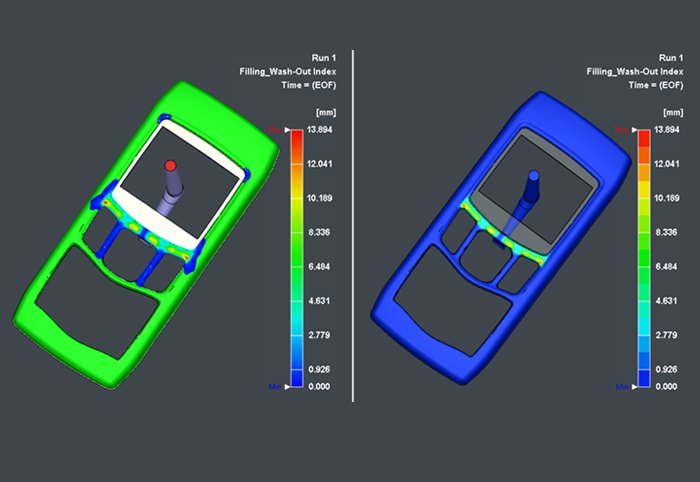
Foil back molding or In Mold Decoration (IMD) refines your components
ESPAECIALLY FOR OUR USERS
If you require a process that enables you to finish your injection molded parts with a film or a coating, then foil back molding is a proven process. This can be simulated in no time with Moldex3D and the corresponding analyses can be carried out …
In-mold decoration is a manufacturing process in which the decorative material is usually fed through the injection mold. It is clamped between the halves of the mold when it is closed. Then the injection of the melt takes place. Thus, the film is pressed against the inner wall of the cavity by its pressure. Meanwhile, the high temperature of the melt causes the lacquer layer of the decorative material or hot stamping foil to bond with the injected material. When the molded part cools down, the lacquer layer of the hot stamping foil detaches from the polyester carrier film used. The finished decorated injection molded part can now be removed. Outside the clamping unit, the spent carrier film is rewound, while at the same time new decorative material is positioned in the designated area of the mold. The IMD process offers a number of advantages over conventional decorative processes, among which cost efficiency in terms of time and resources, efficiency and greater design flexibility can be mentioned.
Moldex3D has the possibility to simulate complex as well as flat and cut geometries and can determine optimal processing conditions to fully exploit the IMD process for optimal molding quality.
When performing a simulation, the corresponding attribute is assigned as usual to the components used for their simulation. Modeling is preferably done with a BLM mesh (Boundary Layer Mesh) and then the positioning and thickness of the decorative film on the component mesh is defined. Finally, materials for the cavity and the IMD film are assigned using the Material Wizard and the process parameters are set in the Process Remote. The process parameters can thus be specifically adapted to the processing conditions of the materials in the injection molding process. During the calculation, the thermal and mechanical properties of the IMD film material are considered in flow, pack, cooling and warpage analyses. The results include familiar attributes like pressure and temperature distribution, shrinkage as well as warpage results and additionally the so called "Wash - Out - Index". This implemented function enables Moldex3D to detect the prediction of the printing ink problem on the IMD film and is used to evaluate the probability of the film peeling or moving due to high shear or temperature during the filling phase.
Should this information have raised your interest, we look forward to your feedback and if you have any further questions, we are more than welcome to help you.
